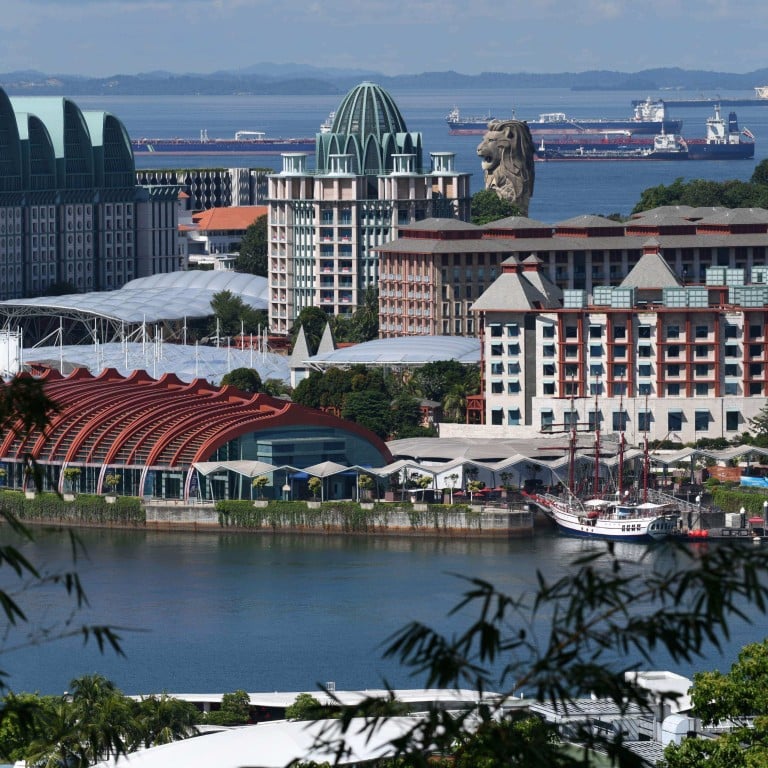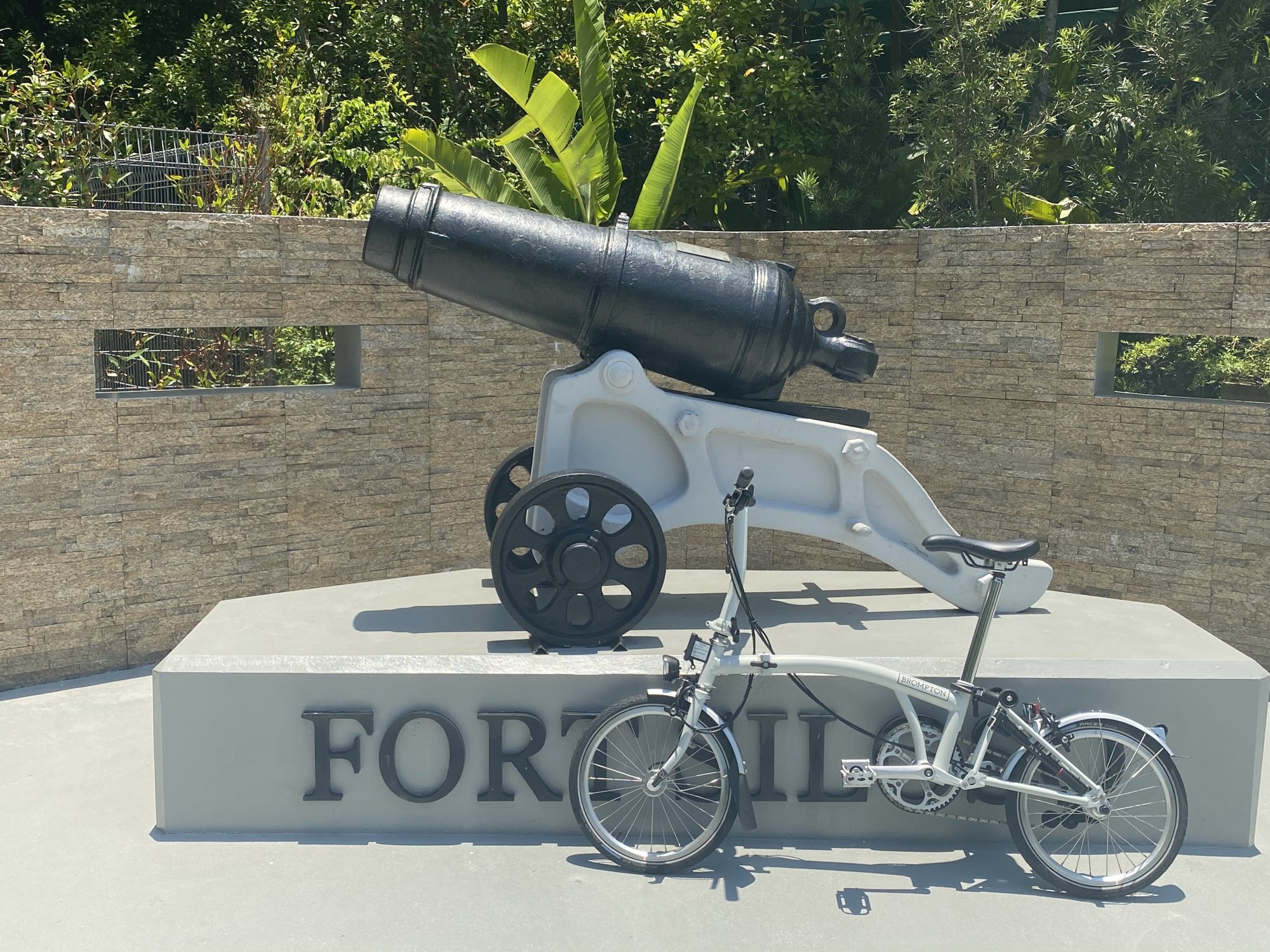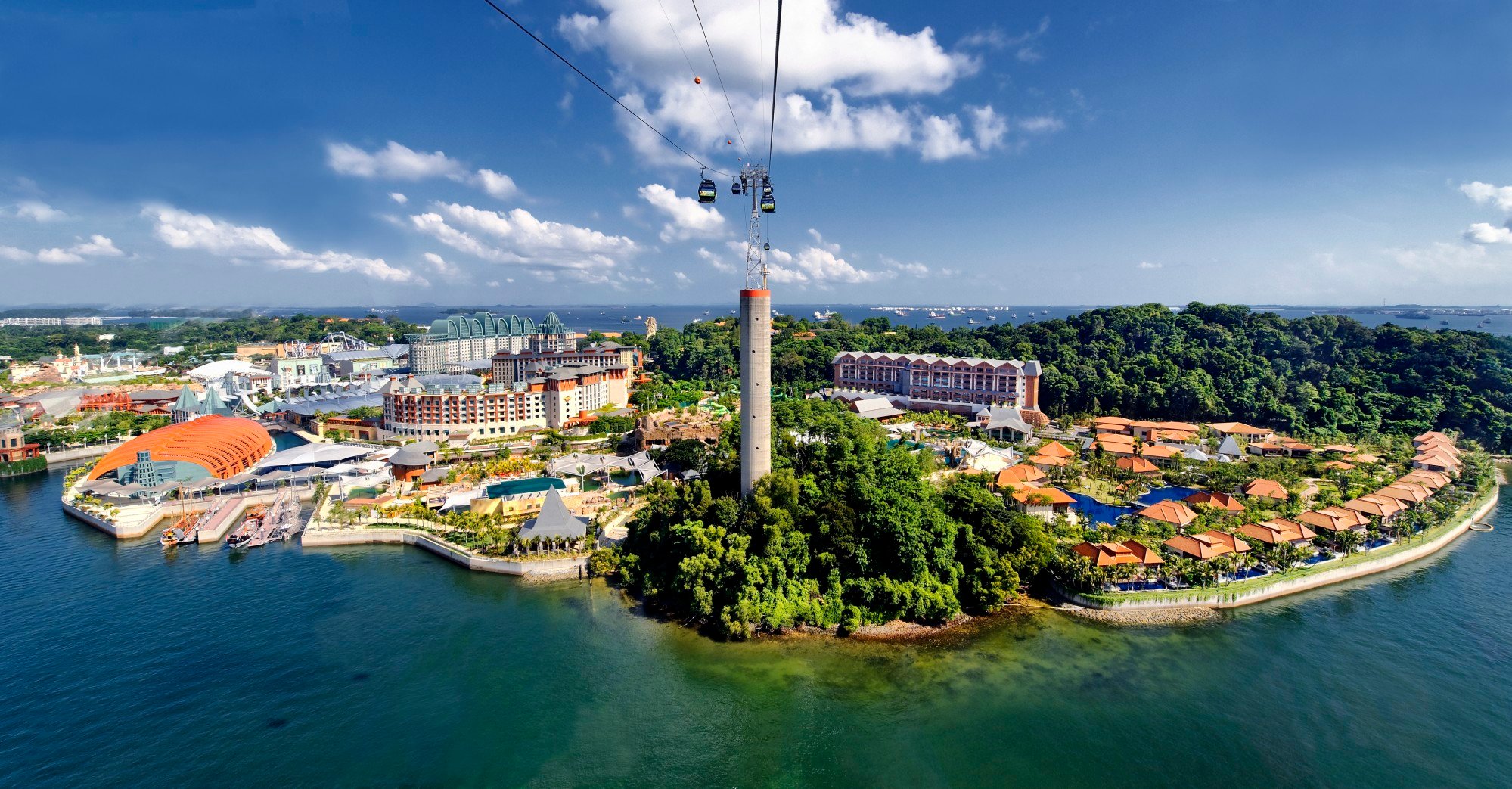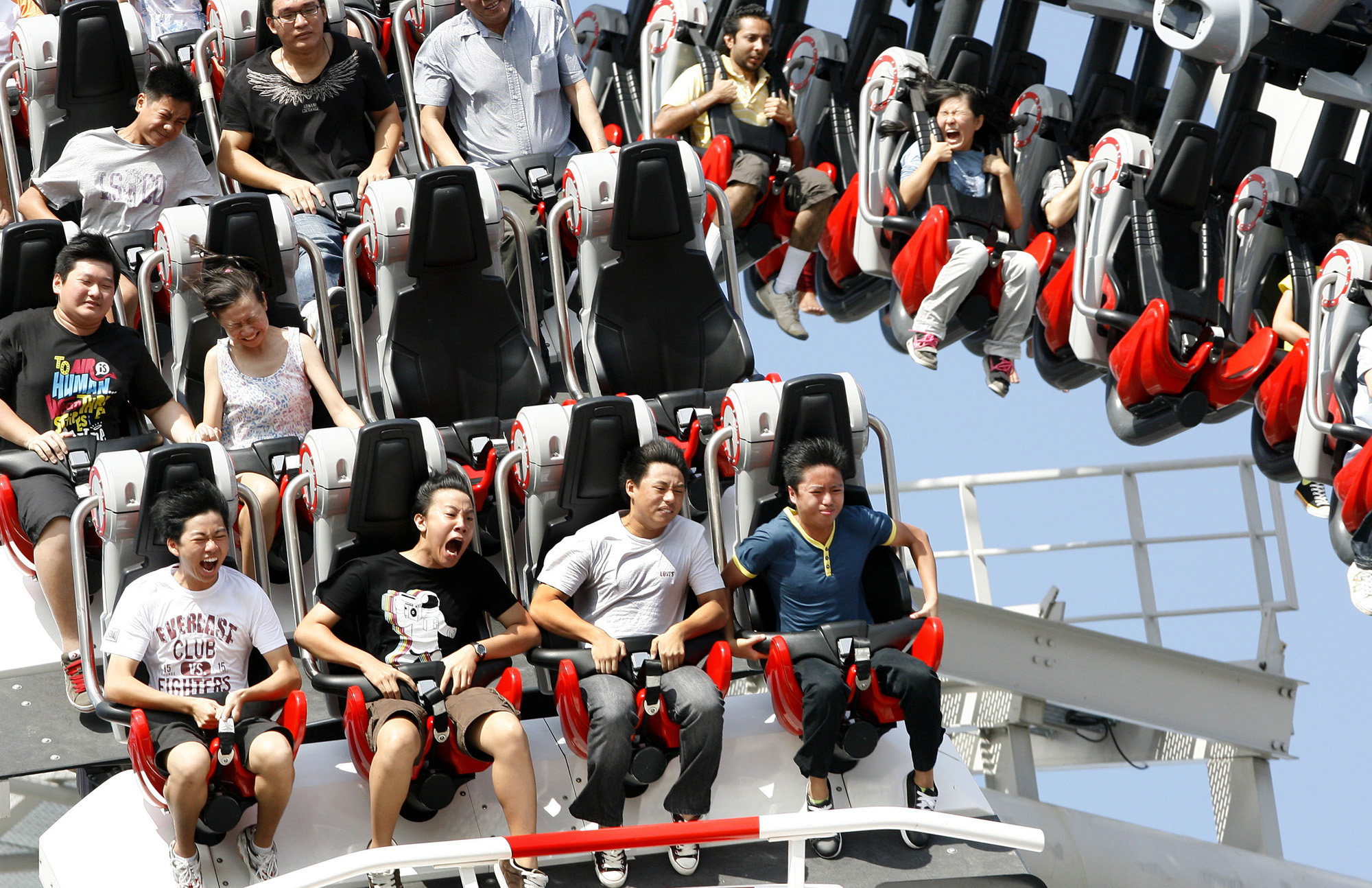
Singapore’s Sentosa Island: from pirates, prisoners-of-war and death to a casino, golf and Trump-Kim
- Sentosa, formerly known as ‘the island behind which lies death’, has a dark and brutal past and very nearly became an oil refinery in the 1960s
- Today, it’s home to the only Universal Studios theme park in Southeast Asia and one of Singapore’s two casinos – as well as some 55,000 trees
After a dark and brutal past involving pirates, malaria, a prisoner of war camp, and mass executions, the island – formerly called Pulau Blakang Mati, or “the island behind which lies death” – almost became an Esso oil refinery.
The government had already agreed with the oil company when a few concerned individuals proposed another idea – why not turn it into a popular tourist destination like Disneyland?
Here’s how it got to be the way it is today.

About a mile off Singapore, you’ll find Sentosa Island, a 500-hectare island shaped like the end of a tobacco pipe.
From above, it looks like a beach-lined Disneyland bordered by forest.
But the island has a dark history. Up until about 50 years ago, it was known as Pulau Blakang Mati, which translates to “the island behind which lies death”.
In the 19th century, it was a regular hiding spot for pirates, and some experts believe its name refers to an area where they buried their dead.
‘Barbarians of the islands’: Chinese merchant’s early account of Singapore
Around this period, the island’s small population was also decimated by what was thought to be malaria.
In the late 19th century, while Singapore was under British control, its forces built five coastal forts across the island, including Fort Siloso on a hilltop.
In 1942, they fought the Japanese from these forts.
When the British lost, the Japanese converted the fort into a prisoner-of-war camp for Australian and British soldiers.

The other forts fell into disrepair. One is now used by hikers as a lookout spot and another, according to CNN, is popular with fans of “ruin porn”.
The Japanese also killed thousands of Chinese men in mass executions on one of Sentosa’s beaches, which was later converted into the Serapong golf course.
In 1965, Singapore was granted independence. Towards the end of the 1960s, its new government agreed to let Esso build an oil refinery on the island.
The plan was to expand it into a petrochemical tank farm.
Singapore’s tanker seizures soar to record highs as Russian dark oil fleet grows
Some people were resistant to the idea of turning the lush island into a refinery.
Alan Choe, a housing and development architect, was asked to think up convincing alternatives.
He did not have much to go on, except the fact the island had been the city’s “green lung”.
In 1967, he wrote a paper that convinced authorities that the island needed to remain a “green lung” and that it could be converted into a tourist destination.

The government agreed to move the refinery to another island and announced plans in 1969 to create a “South Sea Island paradise” in its place.
In 1972, the island was renamed “Sentosa,” which means “peace and tranquillity.” This was the winning entry in a public competition held to rename the island.
The Singaporean government also formed the Sentosa Development Corporation (SDC).
It had big plans for the island, but it wasn’t easy.
How Singapore’s Sentosa Cove went from Crazy Rich Asians to a poor man’s Bali
“It’s always been a military island. When we took over, there was no money, no causeway,” Choe told Channel News Asia. “So, we started by adapting a lot of the old buildings used by the British for military garrisons.”
In 1974, Sentosa’s popularity grew with the opening of the Sentosa Golf Club. It was immediately popular despite charging expensive fees.
SDC also launched cable cars that linked the island to the mainland. They were touted as the first of their kind to go across an entire harbour.
In 1979, about 850,000 people visited the island, but it still wasn’t a hotspot for investment.

Companies complained about insufficient infrastructure and the poor condition of facilities.
In 1983, Sentosa’s development stalled after an oil vessel hit the cable car line. The accident caused two cars to fall into the sea, killing seven people and trapping 13 others.
It was a disaster and the island experienced an immediate slump in visitors and business interest.
To get things moving again, it took tax incentives as well as unique land purchasing rules where developers could pay for part of the land and pay off the rest using their earnings once their developments were up and running.

Still, progress remained slow. As recently as 1989, the island had no proper luxury hotels, just a few youth hostels. But the island became more accessible in 1992 when the Sentosa Causeway opened.
During the 1990s, the SDC focused on getting more hotels to open in Sentosa by investing hundreds of millions of dollars.
But the island’s popularity was already waning. Christopher Khoo, a tourist consultant said Sentosa “evoked the feeling of old or stale attractions”.
Theme parks and attractions opened and closed, including “Volcano Land” and the water park “Fantasy Land”, where two people died. Asia’s largest underwater aquarium “Underwater World”, which opened in 1991, lasted longer than the others, but it also closed down in 2016.
Nostalgia in China as Singapore set to demolish Sentosa merlion
“We built it very tall; people could take a lift up to the top, and we made its eyes like radar lights, flashing all over with smoke coming out and sound roaring out,” Choe told Channel News Asia.
In 2002, the Singaporean government invested US$3 billion into the island to rejuvenate it, including a US$20 million investment to upgrade Palawan Beach and the refurbishment of Fort Siloso.
Sentosa Cove – one of the island’s key developments – was launched in 2003. Based at the tip of the eastern edge of the island, it’s where some of Singapore’s richest citizens live.

The 117-hectare gated community with 2,600 homes is the only place in Singapore where a non-resident can purchase land, but it does not come cheap.
Houses between 7,000 and 10,000 square feet sold for up to US$10 million. In 2022, one sold for US$16 million.
Sales from the elite community brought in hundreds of millions of dollars.
“The idea was for the rich to park the car in the front and the yacht behind,” Choe told Channel News Asia.
Buyers from China are snapping up luxury Singapore property at a record rate
According to the Los Angeles Times, the island has “one foot in fantasy land and one foot in a future in which Singapore embraces, well Southern California, with a gated community of luxury homes and a yacht marina”.
New hotels also began to open in the 2000s, including the Capella Singapore, the W Singapore, and Sofitel Singapore Sentosa Resort & Spa.
New attractions were built as well, including skydiving and a surf simulator.
But it was in 2010 that Sentosa reached the peak of its evolution when Resorts World Sentosa opened, according to Time. This was the first Universal Studios theme park in Southeast Asia.

It was also the location for Singapore’s first casino.
The resort was so large it reclaimed about seven hectares of watery coastline.
People often assume Sentosa Island is man-made. That is not true but, according to CNN, it has grown about 220 hectares since 1972.
Resorts World Sentosa had an immediate impact. From 2010 to 2011, the number of visitors to Sentosa rose from 7.8 million to 19.1 million. And visitor numbers continued to grow every year by almost 20 per cent until the pandemic.

Despite all of the development, Sentosa still acts as a “green lung” for Singapore. It has an estimated 55,000 trees and 45 hectares of secondary forest covering the island, according to a government agency report from 2011.
Singapore’s government has also imposed restrictions to ensure the island remains 60 per cent forest and untouched space.
For instance, Shangri-La Rasa resort is nestled among trees and had to design its driveway around Singapore’s reportedly oldest tree, an Angsana.
Trump-Kim summit: in Singapore, a calm before the media storm
As for the future, the government is planning on connecting Sentosa to a nearby island called Palau Brani to create an even more impressive tourist destination over the next 20 years.
While the pandemic delayed its plans, Sentosa will surely become an even larger, more decadent island destination before too long.

